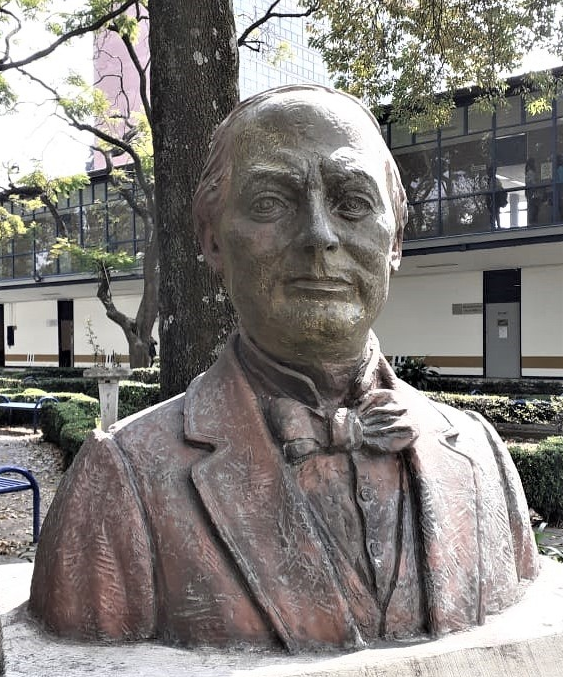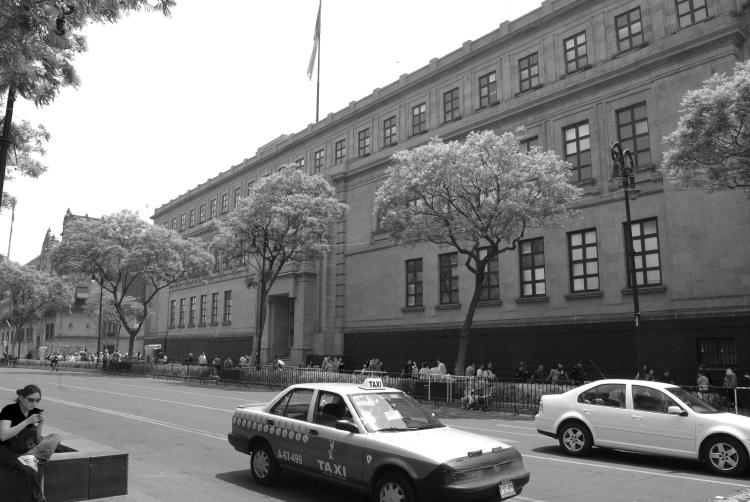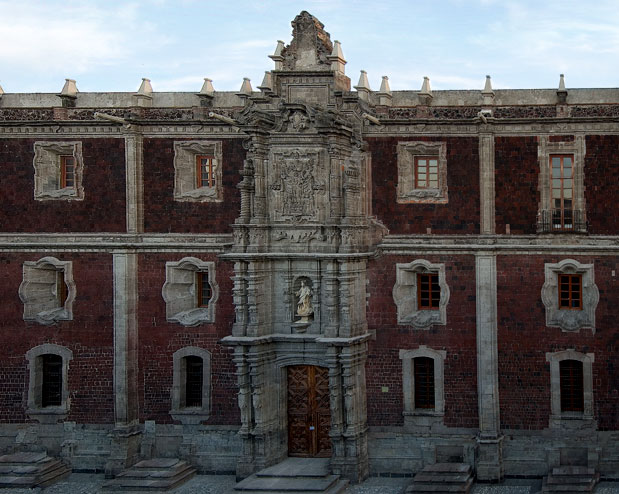|
Sebastián Lerdo De Tejada
Sebastián Lerdo de Tejada y Corral (; 24 April 1823 – 21 April 1889) was Mexican liberal politician and jurist who served as the 27th president of Mexico from 1872 to 1876. A successor to Benito Juárez, who died in office in July 1872, Lerdo de Tejada was elected to his own presidential term in November 1872. Previously, he served as Chief Justice of the Supreme Court. Juárez's political rival, liberal General Porfirio Díaz, had attempted a coup against Juárez, but his Plan de la Noria failed and Díaz was eliminated as a political rival during Lerdo de Tejada's 1872–1876 term, giving him considerable leeway to pursue his program without political interference. During his term, he succeeded in pacifying the country after decades of political unrest and strengthening the Mexican state. He was elected for another term in 1876, but was overthrown by Porfirio Díaz and his supporters under the Plan of Tuxtepec, which asserted the principle of no-reelection to the presidenc ... [...More Info...] [...Related Items...] OR: [Wikipedia] [Google] [Baidu] |
The Most Excellent
The Most Excellent (Spanish language, Spanish: ''Excelentísimo Señor'' (male) or ''Excelentísima Señora'' (female), literally "Most Excellent Sir/Madam") is an honorific prefix that is traditionally applied to certain people in Spain and certain Spanish-speaking countries. Following Spanish tradition, it is an ''ex officio'' style (the holder has it as long as they remain in office, in the most important positions of state) and is used in written documents and very formal occasions. The prefix is similar (but not equal) to that of "Excellency, His/Her Excellency", but in the 19th century "The Most Excellent" began to replace the former. The use of the prefix Excellency was re-introduced in Francoist Spain by ''Generalísimo'' Francisco Franco himself, who was formally styled as ''Military career and honours of Francisco Franco, Su Excelencia el Jefe del Estado'' ("His Excellency The Head of State"), while his ministers and senior government officials continued using the prefix ... [...More Info...] [...Related Items...] OR: [Wikipedia] [Google] [Baidu] |
Miguel Miramón
Miguel Gregorio de la Luz Atenógenes Miramón y Tarelo, known as Miguel Miramón, (29 September 1831 – 19 June 1867) was a Mexican conservative general who became president of Mexico at the age of twenty seven during the Reform War, serving between February 1859 and December 1860. He was the first Mexican president to be born after the Mexican War of Independence. A cadet in military school at the beginning of the Mexican–American War, Miramón saw action at the Battle of Molino del Rey and the Battle of Chapultepec during the American invasion of Mexico City. After the triumph of the liberal Plan of Ayutla in 1855, Miramón participated in a series of conservative counter coups until his efforts merged with the wider Reform War led by conservative president Félix María Zuloaga. The first year of the war was marked by a series of conservative victories achieved by Miramón, leading the press to dub him "Young Maccabee". After a moderate faction of conservatives overthrew ... [...More Info...] [...Related Items...] OR: [Wikipedia] [Google] [Baidu] |
San Luis Potosí
San Luis Potosí (), officially the Free and Sovereign State of San Luis Potosí ( es, Estado Libre y Soberano de San Luis Potosí), is one of the 32 states which compose the Federal Entities of Mexico. It is divided in 58 municipalities and its capital city is San Luis Potosí City. Located in Central Mexico, San Luis Potosí is bordered by seven other Mexican states: Nuevo León to the north; Tamaulipas to the north-east; Veracruz to the east; Hidalgo, Querétaro and Guanajuato to the south; and Zacatecas to north-west. In addition to the capital city, other major cities in the state include Ciudad Valles, Matehuala, Rioverde, and Tamazunchale. History In pre-Columbian times, the territory now occupied by the state of San Luis Potosí contained parts of the cultural areas of Mesoamerica and Aridoamerica. Its northern and western-central areas were inhabited by the Otomi and Chichimeca tribes. These indigenous groups were nomadic hunter-gatherers. Although many indigenou ... [...More Info...] [...Related Items...] OR: [Wikipedia] [Google] [Baidu] |
Maximilian I Of Mexico
Maximilian I (german: Ferdinand Maximilian Josef Maria von Habsburg-Lothringen, link=no, es, Fernando Maximiliano José María de Habsburgo-Lorena, link=no; 6 July 1832 – 19 June 1867) was an Austrian archduke who reigned as the only Emperor of the Second Mexican Empire from 10 April 1864 until his execution on 19 June 1867. A member of the House of Habsburg-Lorraine, Maximilian was the younger brother of Emperor Franz Joseph I of Austria. He had a distinguished career as the Austrian viceroy of Lombardy–Venetia and the commander-in-chief of the Imperial Austrian Navy. His involvement in Mexico came about after France, together with Spain and the United Kingdom, had occupied the port of Veracruz in the winter of 1861 to pressure the Mexican government into settling its debts with the three powers after Mexico had announced a suspension on debt repayment earlier in the year; the Spanish and British both withdrew the following year after negotiating agreements with the Mex ... [...More Info...] [...Related Items...] OR: [Wikipedia] [Google] [Baidu] |
Second French Intervention In Mexico
The Second French Intervention in Mexico ( es, Segunda intervención francesa en México), also known as the Second Franco-Mexican War (1861–1867), was an invasion of Mexico, launched in late 1862 by the Second French Empire, which hoped to replace the Mexican Republic with a monarchy favorable to French interests. After the administration of President of Mexico, Mexican President Benito Juárez placed a moratorium on foreign debt payments in 1861, France, the United Kingdom, and Spain agreed to the Convention of London (1861), Convention of London, a joint effort to ensure that debt repayments from Mexico would be forthcoming. On 8 December 1861, the three navies disembarked their troops at the port city of Veracruz (city), Veracruz, on the Gulf of Mexico. However, when the British discovered that France had an ulterior motive and unilaterally planned to seize Mexico, the United Kingdom separately negotiated an agreement with Mexico to settle the debt issues and withdrew fro ... [...More Info...] [...Related Items...] OR: [Wikipedia] [Google] [Baidu] |
United Kingdom
The United Kingdom of Great Britain and Northern Ireland, commonly known as the United Kingdom (UK) or Britain, is a country in Europe, off the north-western coast of the continental mainland. It comprises England, Scotland, Wales and Northern Ireland. The United Kingdom includes the island of Great Britain, the north-eastern part of the island of Ireland, and many smaller islands within the British Isles. Northern Ireland shares a land border with the Republic of Ireland; otherwise, the United Kingdom is surrounded by the Atlantic Ocean, the North Sea, the English Channel, the Celtic Sea and the Irish Sea. The total area of the United Kingdom is , with an estimated 2020 population of more than 67 million people. The United Kingdom has evolved from a series of annexations, unions and separations of constituent countries over several hundred years. The Treaty of Union between the Kingdom of England (which included Wales, annexed in 1542) and the Kingdom of Scotland in 170 ... [...More Info...] [...Related Items...] OR: [Wikipedia] [Google] [Baidu] |
President Of The Chamber Of Deputies (Mexico)
The President of the Chamber of Deputies (Spanish: ''Presidente de la Cámara de Diputados'') is the presiding officer of the Chamber of Deputies of Mexico. This position is analogous to the Speaker of the House in other legislatures. The incumbent president is Sergio Gutiérrez Luna. The president is elected for a one-year term. One of the main characteristics of the position is assuming the role of President of the Congress of the Union during joint-sessions of General Congress, including: the ceremonial opening of ordinary (and extraordinary) legislative periods, the inaugural ceremony of the President of Mexico where this presiding officer receives the presidential sash from the outgoing president to deliver it to the incoming president, and the reception of the President of Mexico's yearly government report at the beginning of every legislative year (traditionally a speech to Congress but also delivered in writing without the President's attendance since 2007) as well as de ... [...More Info...] [...Related Items...] OR: [Wikipedia] [Google] [Baidu] |
Ignacio Comonfort
Ignacio Gregorio Comonfort de los Ríos (; 12 March 1812 – 13 November 1863), known as Ignacio Comonfort, was a Mexican politician and soldier who was also president during one of the most eventful periods in 19th century Mexican history: La Reforma. He played a leading role in the liberal Plan of Ayutla which overthrew the dictatorship of Santa Anna in 1855, and then served in the cabinet of the new president, Juan Alvarez. He gained a reputation as a moderate and assumed the presidency when Alvarez stepped down after only a few months. The Constitution of 1857 was drafted during his presidency. The constitution was met with opposition from conservatives and the Catholic Church when it was promulgated in February 1857 over its anti-clerical provisions, most notably the Lerdo law, which stripped the church of most of its rural properties. The measure also forced Mexico's indigenous peoples to sell sizeable portions of their communal lands. Controversy was further inflamed when ... [...More Info...] [...Related Items...] OR: [Wikipedia] [Google] [Baidu] |
Supreme Court Of Justice Of The Nation
The Supreme Court of Justice of the Nation ( es, Suprema Corte de Justicia de la Nación (SCJN) is the Mexican institution serving as the country's federal high court and the spearhead organisation for the judiciary of the Mexican Federal Government. It consists of eleven magistrates, known as ''ministers of the court'', one of whom is designated the court's ''president''. Judges of the SCJN are appointed for 15 years.Article 94 Mexican Constitution They are ratified through affirmation by the Senate from a list proposed by the President of the Republic. The ministers chosen will select from among themselves who shall be the President of the Court to serve a four-year period; any given minister may serve out more than one term as president, but may not do so consecutively. Requirements for holding a seat on the Supreme Court of Justice of the Nation * Be a natural born citizen of Mexico. * Be no less than 35 years of age nor over 65 years of age at the time of one's appoint ... [...More Info...] [...Related Items...] OR: [Wikipedia] [Google] [Baidu] |
Mexico City
Mexico City ( es, link=no, Ciudad de México, ; abbr.: CDMX; Nahuatl: ''Altepetl Mexico'') is the capital and largest city of Mexico, and the most populous city in North America. One of the world's alpha cities, it is located in the Valley of Mexico within the high Mexican central plateau, at an altitude of . The city has 16 boroughs or ''demarcaciones territoriales'', which are in turn divided into neighborhoods or ''colonias''. The 2020 population for the city proper was 9,209,944, with a land area of . According to the most recent definition agreed upon by the federal and state governments, the population of Greater Mexico City is 21,804,515, which makes it the sixth-largest metropolitan area in the world, the second-largest urban agglomeration in the Western Hemisphere (behind São Paulo, Brazil), and the largest Spanish language, Spanish-speaking city (city proper) in the world. Greater Mexico City has a gross domestic product, GDP of $411 billion in 2011, which makes ... [...More Info...] [...Related Items...] OR: [Wikipedia] [Google] [Baidu] |
Colegio De San Ildefonso, Mexico City
Colegio de San Ildefonso, currently is a museum and cultural center in Mexico City, considered to be the birthplace of the Mexican muralism movement. San Ildefonso began as a prestigious Jesuit boarding school, and after the Reform War it gained educational prestige again as National Preparatory School. This school and the building closed completely in 1978, then reopened as a museum and cultural center in 1992. The museum has permanent and temporary art and archeological exhibitions in addition to the many murals painted on its walls by José Clemente Orozco, Fernando Leal, Diego Rivera and others. The complex is located between San Ildefonso Street and Justo Sierra Street in the historic center of Mexico City. The college was founded 1588 and it is composed of six sections, that are five colonial baroque: the Colegio Grande, Colegio Chico, the chapel, El Generalito and the courtyard of los Pasantes, all completed in 1749; and one modern neo-baroque: the Amphitheater Bolíva ... [...More Info...] [...Related Items...] OR: [Wikipedia] [Google] [Baidu] |
Puebla City
Puebla de Zaragoza (; nah, Cuetlaxcoapan), formally Heroica Puebla de Zaragoza, formerly Puebla de los Ángeles during colonial times, or known in English simply as Puebla, is the seat of Puebla Municipality. It is the capital and largest city of the state of Puebla, and the fourth largest city in Mexico, after Mexico City, Monterrey, and Guadalajara. A viceregal era planned city, it is located in the southern part of Central Mexico on the main route between Mexico City and Mexico's main Atlantic ocean, Atlantic port, Veracruz, Veracruz, Veracruz—about east southeast of Mexico City and about west of Veracruz. The city was founded in 1531 in an area called Cuetlaxcoapan, which means "where serpents change their skin", between two of the main indigenous settlements at the time, Tlaxcala and Cholula (Mesoamerican site), Cholula. This valley was not populated in the 16th century, as in the pre-Columbian, pre-Hispanic period this area was primarily used for the "flower wars" betw ... [...More Info...] [...Related Items...] OR: [Wikipedia] [Google] [Baidu] |




